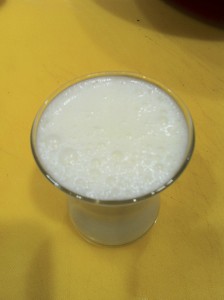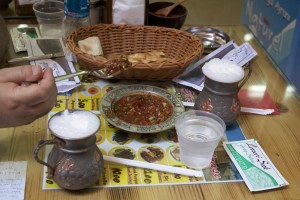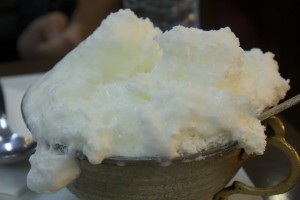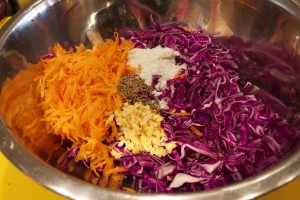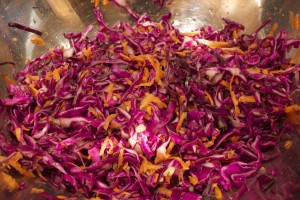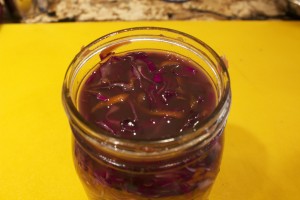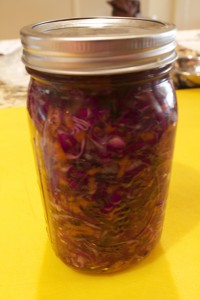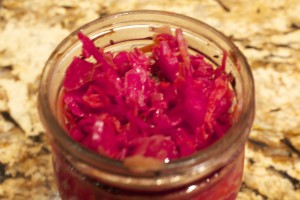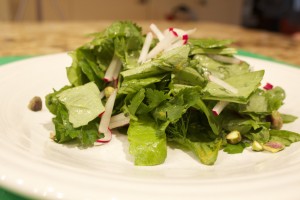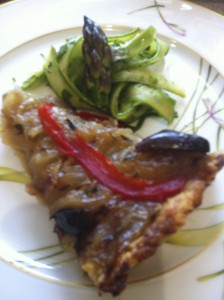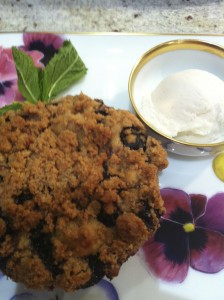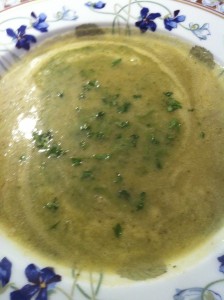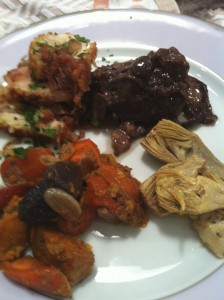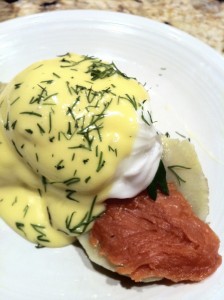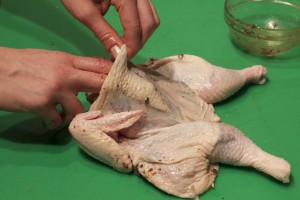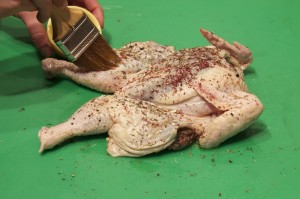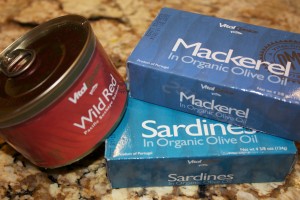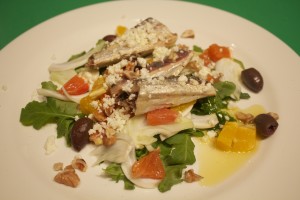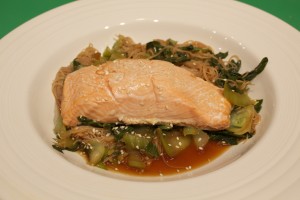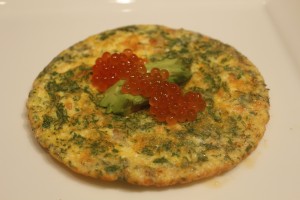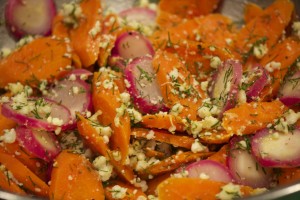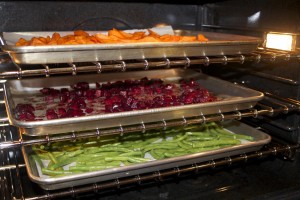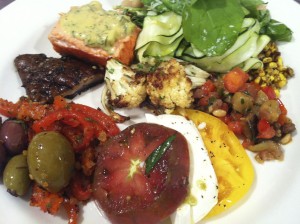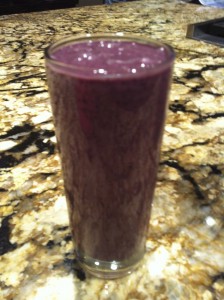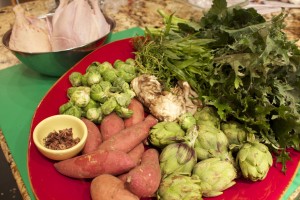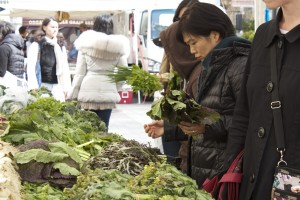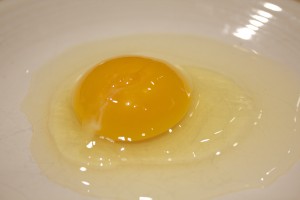
|
Ayran, National Beverage of Turkey I’ve been immersed in Turkish culture and food lately. Tonight I’m giving my first class of three Turkish classes at the New York Open Center. We will start off the meal with Aryan, which is one of the national beverages of Turkey. Rumi, the great 13th century mystic and poet, who cloaked spiritual truths in food terminology, referenced this beloved drink when he said that “just as the fat is hidden in ayran, the essence of truth is buried in lies.” Just like any other food, in Turkey there are delicious versions of this drink that are made fresh, and then there are insipid packaged varieties. You make it yourself by straining yogurt until really thick, which takes about 6 hours. Make sure to use full-fat organic (preferably with the cream on top) for best results. Whisk a cup of the thick yogurt with water (about three cups) until frothy. Add about ¼ teaspoon salt and whisk that in as well. I like serving it in small tea cups like an aperitif. This is what ayran looks like in Turkey, when it’s made fresh. It’s frothed with a machine and resembles cappuccino foam on steroids. It’s often served in beautiful mugs. This next example was the most spectacular and the foamiest ayran that I tasted. How does this man, with the most dashing mustache in Turkey, drink his Ayran? Amazing hair this man has, but a little awkward when drinking Ayran. You can drink Ayran with a ladle, especially when it’s that frothy. What a way to enjoy yogurt!
Red Cabbage Lacto-Fermented Sauerkraut Lately, I’ve been on a lacto-fermenting frenzy, fermenting everything from red cabbage to dill pickles to beet and fruit kvass. The lactobacilli, which are good bacteria, proliferate in fermented vegetables and fruit. The vegetables and fruit are easier to digest and the vitamin levels are increased as well. The main by-product of lacto-fermentation is lactic acid, which promote the growth of healthy flora throughout the intestine. What I like about these fruits and vegetables is that once they’re fermented, they last for a long time in the refrigerator. They’re an instant quick hit of super nutrition. Moreover, they are easy to produce. Here’s one of my favorites, a red cabbage ferment, that needs only salt to get the whole process of fermentation going. The salt inhibits any bacteria that could putrify the ferment until the lactic acid forms. I start with a head of finely shredded red cabbage. I add some shredded carrots, a piece of minced ginger, a tablespoon caraway seeds, and two tablespoons Celtic sea salt. After stirring everything together, I massage the mix with my hands to help the cabbage release its juices. There’s no need to add water to the brine when you make a cabbage ferment.. You can pound that cabbage with a mallet or just put a weight on the cabbage ( a bowl with a weight in it works well). and it will start sweating away in no time. I then stuff the mix into a jar (a one quart bell jar is perfect) pressing down to make sure that there’s liquid floating on top. I make sure to have an inch of space at the top. (This is quite important to avoid leaks.) I leave this on my kitchen counter for 3 to 5 days. With a bell jar, the piece in the middle is hard to press down when the ferment is complete. The red cabbage doesn’t look so bright in the beginning, but as it ferments it turns a beautiful magenta color. It’s best to transfer this to the refrigerator, where it can last a long time (up to a year) without opening. Once opened, it’s good for about three months. Share on Facebook and Twitter | condiments, Health Tips, Kitchen Tips, Side Dishes, techniques, Vegetables | No comments
Summer Herb Salad Herbs are fresh and abundant in warm weather, and I love using all different kinds regularly in my dishes. I often turn the bits and pieces that are inevitably left over—especially from the leafy ones—into an herb salad. I start with a base of a zesty green like watercress or arugula and then add whatever I have. In this video, I’ve put together a mix of watercress, parsley, dill, cilantro, and sorrel. Sorrel gives the salad a delicious lemony punch and is in season all summer. Other herbs I’ve used include chives, tarragon, mint, chervil and lovage. Every mouthful is exciting! I make a simple dressing to complement the herbs. It consists of 1 part lemon juice to 2 parts extra virgin olive oil, along with some lemon zest and a sprinkling salt and pepper. I place everything in a jar, shake it for 10 seconds to mix, and I’ve got a tasty dressing that will keep refrigerated for up to two weeks. This salad is topped with matchstick radishes and a sprinkling of pistachios, but this base lends itself to a large array of possibilities. A piece of sautéed fish or chicken turns the salad into a light main course as well. Herbed Salad with Lemon-Olive Oil Vinaigrette Share on Facebook and Twitter | Uncategorized | No comments
Catering Gig This past Friday and Sunday, I catered a couple of on-site parties. I had Wednesday and Sunday morning to prepare for the Sunday brunch, and Thursday and Friday to prepare for the Friday evening party. Since I had to prepare a good amount in advance of Sunday, I had to plan on a certain number of dishes that would freeze or hold well for up to five days. These individual cheesecakes fit the criteria. As they rest in the refrigerate, they just keep on getting tastier, so making them five days ahead was not a stumbling block. I bought the molds at J.B. Prince, an amazing store on 31st street in NYC. I froze a batch of crepes (which were to be filled with strawberry-rhubarb compote), zucchini pancakes, lasagna, and this caramelized onion tart.
I made the Friday desserts Friday afternoon. This is the blueberry buckle from the Healthy Hedonist Holidays. This is a chocolate cake made in individual aluminum ramekins. Powdered sugar covers a multitude of craters. The Friday night meal had as a starter the Turkish chopped romaine salad and the miso-marinated black cod from The Healthy Hedonist. I marinated the cod early in the day (marinade made the day before) and just tossed it in the broiler to brown. Before serving I blasted the fish in a hot oven to reheat; the oily fish is so forgiving it was not in the least bit dried out . The stock for the broccoli soup was made Wednesday and the soup and pistou topping were finished Thursday. The main course included braised short ribs and stuffed chicken (a great way to keep the chicken moist) as well as braised-roasted purple potatoes, sweet potatoes and carrots, and lemony sautéed artichokes. I planned the main course to have items on it that would reheat well without drying out. For the Sunday buffet I did cook a couple of items that required precise timing, but not too many. One of the most important things about cooking for a crowd–beside being organized–is to have a menu that is a bit forgiving. Share on Facebook and Twitter | Dinner, Main course, Musings, Side Dishes, Where To Buy (Sources) | No comments
Kalustyan’s I describe Kalustyan’s, on 123 Lexington, between 28th and 29th streets, as the store that sells everything from everywhere. This is the place to go to get exotic ingredients for ethnic recipes. The spice room itself is the size of an entire shop. Looking for Urfa or Biba peppers from Turkey? No problem. Do you want mastic, berber powder, or mild smoked paprika? All of them are available. The selection of black peppercorns includes those from Turkey, Iran, and India. Since there’s a high turnover, nothing seems to sit on the shelf for too long, and the spices are fresh. Kalustyan’s also has an impressive array of condiments imported from around the world. You’ll find every brand of tamarind that is imported, as well as every type of rose petal and orange blossom water as well. There’s an impressive array of salts and an even more impressive selective of grains and legumes. They also sell fresh curry leaves, Thai chiles, and lemongrass as well frozen kaffir lime leaves and galangal for Southeast Asian cooking. Every trip I take to Kalustyan’s is a fascinating culinary education. Often when I am finished with shopping, I go upstairs and have a bite at the deli counter where Chester Arthur was sworn in as president. (If you want to read the whole placard that is on the wall, read the blog piece on “Amusing Trivia about Kalustyan’s.”) The fellow who works the deli counter is a generous soul who takes pride in his dishes. He makes each mujadarrah (lentils and rice with caramelized onions) sandwich with care, and he varies the offerings daily. He’ll give you a taste of any of the dishes to sample. Kalustyan’s has a great selection of books on middle eastern and ethnic cooking at the counter as well. For those of you that don’t live in New York, you can order from the website http://kalustyans.com. They ship nationwide. Share on Facebook and Twitter | Where To Buy (Sources) | No comments
Poached Eggs Poached eggs not only are suitable for brunch, but with the right accompaniments, make a light and nutritious supper as well. If you keep in mind three basic pointers, poached eggs are not difficult to master. With fresh eggs, the right temperature water, and a little care in adding the eggs, you’ll have beautifully formed creations every time. Watch this demo to see all three key steps. Use the freshest eggs that you can find to keep the proper shape of the white intact. Very fresh eggs—like that kind that you get from your local farmer—cook up perfectly without anything added to the water. If your eggs are not farm-fresh, add a teaspoon salt and a couple of teaspoons vinegar to your pot of simmering water to help coagulate the egg whites. Have the water ready at a simmer. You don’t want the eggs to be torn apart by agitation, which is what faster boiling water will do. On the other hand, if the water is not hot enough, the eggs will not cook quickly enough and the whites of the eggs will spread. Gentle bubbles in the water are the cue that the temperature is correct. Break the eggs one at a time into a dish or small plate. Create a little whirlpool by swirling a spatula or spoon in the water. Then drop the eggs— one at a time— into the whirlpool. (You can also slide the eggs in along the sides of the pot.) Simmer 3 to 5 minutes, until the whites are coagulated but the yolks are still soft. Remove the eggs from the pan with a slotted spoon or skimmer. Drain very well and serve. You can trim off any ragged edges if you like. If you want to make a large number of poached eggs but not serve them right away, immediately plunge the cooked ones into cold water. Reheat briefly in hot water right before serving. The classic here is eggs benedict, and yes, it is mighty tasty. For a variation, try serving the eggs over a steamed artichoke and smoked salmon in lieu of the English muffin and bacon. One delicious and light way to serve poached eggs is on a bed of wilted spinach and smoked salmon. I make a quick blender sauce of yogurt, avocado, cilantro, a bit of salt and a sprinkle of lime juice and ladle it over the top. It’s delicious and satisfying.
Share on Facebook and Twitter | Breakfast, Eggs, techniques | No comments
Sumac Chicken When my photography teacher waxed enthusiastic about his favorite sumac chicken, I started thinking about how much I like the sour, astringent flavor that that the purple spice imparts to dishes. I am especially fond of the combination called za’atar, a mix of sumac, thyme, and sesame seeds, which is typically baked into Middle Eastern flat breads. I hadn’t cooked with sumac for a while, and the thought of making a delicious chicken with the spice was intriguing. My first version, which had sumac and salt rubbed in, over, and around the chicken was tasty, but not as tasty as I wanted. The flavor needed a bit more complexity. The next two versions were delicious. First I mixed fresh thyme, salt, sumac, minced garlic, and extra virgin olive oil into a paste. I butterflied open the chicken, then slipped the paste under the skin of the chicken I had bought at Union Square green market. I flipped the chicken and then brushed it with olive oil, and sprinkled it with more sumac, some dried thyme, and some garlic powder, salt and freshly ground black pepper.
I then transferred the chicken to the refrigerator to let the flavors seep into the meat. It’s great if you can make this dish a day in advance and let it marinate overnight. So far I’ve cooked the chicken two ways. The first time I just placed it on a rack and put it in a 400˚F oven for about 50 minutes until a thermometer in the thigh registered about 175˚F.
The next time I set the chicken on a grill pan skin side down and put a weight on it. I used this nifty iron, but a cast iron skillet or anything weighty works just as well. I grilled it over medium-high heat for about 8 minutes until some serious browning appeared, and I then flipped the chicken and transferred it to a rack in a pan and placed it in a 350˚F. oven for another 40 minutes. It was delicious this way, even almost tasting as if it had been grilled outdoors. Of course you could grill it on an outdoor grill, but for me, in Manhattan, this was not a possibility. The bird was succulent, with bright zesty flavor. I served it with mujadarrah (rice and lentils with caramelized onions) and salad one time, and mujadarrah and roasted asparagus another. Share on Facebook and Twitter | Dinner, ingredients, Main course | No comments
Eating for Radiant Skin: part 3 A Word about Fat: Fat is important for skin health. It’s a mistake to be on a low-fat or no-fat diet. You need fat in order to digest, transport, and absorb Vitamin A,D,E, and K. It’s soothing to the nervous system. Every cell in the body has a surrounding membrane – which is where communication between cells take place – that is made up of fat. You need an array of fats. You need saturated fats to maintain structure; mono and polyunsaturated fats to maintain elasticity. All fats and oils that we consume are made up of a combination of monounsaturated, polyunsaturated, and saturated fats. Polyunsaturated fats, also know as omega 3’s and 6’s, are the ones your body does not make. These are called essential fatty acids because you have to get them from food sources. Omega 3’s are good for countering inflammation in the body. Good sources for omega 3’s are fatty fish such as sardines, anchovies, tuna, and salmon; nuts, seeds, and organic eggs. Because of the standard American highly refined diet, most people have far too many Omega 6’s and not enough Omega 3’s. The ideal ratio is somewhere between 1 to 4 times as much omega 6’s as 3’s. Most Americans get 20 times more omega 6’s than 3’s. Poor quality oils and feed lot meat contribute to an excess of Omega 6 fatty acids in the body. It is easy to get good quality Omega 6’s from whole nuts and seeds, where they are less likely to be rancid. Refined polyunsaturated oils are unstable; they are exposed to high temperatures, chemical solvents, light and oxygen. The essential oils in them are destroyed, and they are rancid and oxidized. They suppress the immune system and cause inflamation. Eating a lot of polyunsaturated oil increases cholesterol in the tissues and cell membranes. The best fats for cooking, which can take the heat without becoming rancid or oxidized, are butter, ghee (clarified butter), olive oil, coconut oil, and sesame oil. To get a good supply of omega 3’s, I turn to the tinned fishes that I keep in my pantry. From these pantry staples I have developed nutritious, delicious meals that I can get on the table in minutes. A couple of years ago I met the folks at Vital Choice when I was at the wise traditions conference. They had a lot of samples of their fish, including everything from the tinned mackerel, sardines, and salmon to the wild king salmon. They were by far the most delicious tinned fish I had ever tasted, and I was impressed with the flash frozen salmon as well. We were served smoked cod from them as a first course as well, another delicious fish they sell. I returned home from the conference with multiple tins of each pantry staple and I ordered a lot more stuff when I returned home. Now I make sure to keep a supply of the flash-frozen salmon as well in my freezer. (By the way, the Vital Choice catalogue is extensive, and among other products includes macadamia nut oil, dark chocolate, and a variety of different kinds of fish oil.) One of my super quick go-to lunches is either the mackerel (or sardines) mashed with avocado, lemon, and salt on a bed of greens. I eat it on a bed of greens. Here’s a quick video on how to make it: Here’s a composed salad made with the sardines: Here’s a quick video on how to make it: Another quick dish that I make a lot is with the flash-frozen wild salmon. Here’s the video on how to make this: This last dish is made with the canned salmon and fresh salmon roe. Salmon roe is a nutritional powerhouse, loaded with anti inflammatory omega 3’s as well as Vitamin A and D. Here’s how to make it: Delicious, nutritious, fast, and easy!
Share on Facebook and Twitter | Breakfast, Dinner, Eggs, Fats & Oils, Health Tips, Lunch, Main course, Pantry Items | No comments
Eating for Radiant Skin: Part 2 Free radicals – we hear that word thrown around a lot – are electromagnetic unbalanced molecules that are internally generated in our bodies. They are created through the process of burning oxygen. Your own metabolism naturally does this, so you make your own free radicals just by living, breathing, and metabolizing. A free radical’s mission is to find an electron it can steal and make its own. Free radicals are produced as a byproduct of normal metabolism, so your body has ways of dealing with them. Inflammation in the body also causes free radicals. Exposure to toxicity produces free radicals. That includes too many environmental pollutants and radiation, including too much sun exposure. Sometimes you hear the term oxidative stress, because oxygen is initially involved in the process of free radical creation. Unfortunately, a victim of free radical damage is collagen, which keeps skin looking plump and elastic. The good news is that skin cells are always dying off and are being replaced by new cells. You do have the opportunity to improve your skin by enhancing your overall health, so that when you replace your old cells, your new cells will be healthy cells. (In a nutshell, that’s why when you start to eat better, your skin looks better as well.) Include foods that contain antioxidant nutrients. A diet rich in antioxidants helps you to have healthy, glowing skin. Antioxidants travel around the body and donate one of their electrons to each free radical that is seeking one. When they do this, the free radicals stop tissue damage. The best known antioxidants are Vitamins A and Betacarotene, Vitamin C, and Vitamin E. Also, there are phytochemicals in plant foods. These are various plant chemicals that contain antioxidants, even though they’re not vitamins and minerals. Phytochemicals are protective against cancer and other degenerative diseases, and are related to pigments in fruits and vegetables. So that is why you often hear that’s it’s good to eat a rainbow of vegetables:
Orange: carrots, apricots, pumpkins, red: tomatoes and cherries, green: avocados, leafy greens, brown; nuts and seeds, blue: blueberries and blackberries. A lot of these not only contain phytochemicals but Vitamin A, C, and E as well. One example of a phytochemical is a flavonoid, which is found in the pulp of foods containing Vitamin C, which is WHY it is better to have food in the whole food source than in a juice. Foods with Vitamin A and Betacarotene:
By the way, food with too much beta-carotene can turn your skin orange, which is what happened to me in my youth. This is not a harmful condition, but it does indicate that one is not converting all of the beta-carotene to Vitamin A. Foods with Vitamin E:
Foods with Vitamin C:
Share on Facebook and Twitter | Health Tips | No comments
Eating for Radiant Skin: Part 1 I recently gave a lecture to some folks at Beauty Bank, a division of Estée Lauder, on eating for healthy skin. We then cooked a delicious luncheon that was rich in anti-oxidants and phytochemicals. Preparing the lecture got me thinking a lot about free radical damage and what contributes to good skin from the inside out. There’s so much to say about this, that I’ve divided it into three parts. Part one is simply the basics of a good diet. While individual components may vary, there are some general principles that are applicable to all. The Quality of Food Counts Eat whole foods rather than refined. Whole foods are the edible parts of foods that are as close to their natural state as possible. Here’s a visual on whole foods: Whole foods should be prepared in a way that retains enough nutritional value to be supportive of health. Beans and grains, for instance, should be soaked overnight (with juice of 1/2 lemon) to improve digestibility. Nuts should be soaked if possible. Whole foods can be puréed into a soup – it’s still whole – but a juice, although nutritious in some ways, is not a whole food. (More about this in part two.) Refined foods have been processed so that most of the nutrients have been stripped away. They are nutrient thieves; they rob your body of stored nutrients in order to make the energy it takes to digest them. Refined sugar is a prime example of this. Eat Real Food, Not Fake Heres’s an example: soy sauce, called shoyu (traditionally processed soy sauce) should just have in it soy, wheat, water and salt. It takes six months for it to ferment naturally and it’s a healthful condiment. The fake varieties have caramel coloring, all kinds of additives, and have been processed overnight. They are a bottle of flavored chemicals. That’s a fake food. Most real food has a short shelf life (there are, of course notable exceptions such as vinegars, sea vegetables, and other condiments.) Food is best fresh and harvested when ripe. If possible, go to grocery stores that buy local food, or better yet, frequent a farmers market to purchase seasonal food, which happens to be in harmony with nature. Seasonal food is the freshest, most cost effective, most organic, and most flavorful. Seasonal food helps your body adapt to changes in temperature. In winter it’s time for soups and stews, grains, and root vegetables. Spring has strawberries, asparagus, and leafy greens. These help clear waste that has accumulated over winter. Summer has a large variety of wet food, juicy fruits, lettuces, and summer squash that help our bodies stay hydrated and cope with hot weather. Buy organic when possible. Organic soil is replaced by a full spectrum of nutrients. The soil in conventional farming only has nitrogen, phosphate, and potassium. This leaves me wondering what happened to the other sixty nutrients we aren’t getting. I do think local is most important when it comes to vegetables and fruits. While shopping at a green market, you have the opportunity to ask the farmer about his farming practices. He may not be certified organic, but he may be in practice, or he may spray only minimally, and he probably replenishes his soil. A good website is foodnews.org, which lists the dirty dozen produce that is most heavily sprayed as well as the cleanest fifteen fruits and vegetables that are the least sprayed. It’s important to note that GMO foods (conventional soy, corn – not the sweet corn-on-the-cob variety, and wheat) are engineered to withstand huge amounts of pesticides. So when you eat GMO foods, you are getting a pesticide load. The Most Important Foods to be High Quality: All animal foods fall into this category. Eggs, for instance provide 8 essential amino acids and they are nature’s perfect food (of course, if you’re allergic, it’s not YOUR perfect food. ) The yolk is the most nutritious part of the egg; the nutrient list reads like a multivitamin, so please, no egg white omelets! The best nutrient dense eggs are from pastured chickens, those that have been running around pecking in the ground along with their supplemental diet of feed. The best beef, chicken, lamb and dairy are from pastured animals that have been roaming around eating pasture. They should not be finished in feed lots. Grass fed really means grass finished. All animals start out on grass but a healthy animal finishes its life on grass as well. The nutrient profile in an animal that has been finished on grass is completely superior to those which have been feedlot and grain finished. Fish should come from sustainable fisheries. Salt should have a good mineral content. Unrefined sea salt has 80 trace minerals in a form easily absorbed by the today. Use the right amount of good salt to make your foods burst with flavor and avoid processed food. Share on Facebook and Twitter | Health Tips | No comments
|
